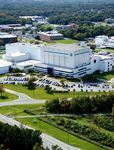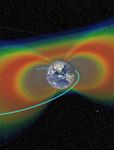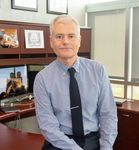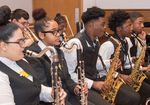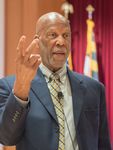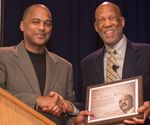National Aeronautics and Space Administration Volume 15 Issue 1 January - February 2019 - NASA
←
→
Page content transcription
If your browser does not render page correctly, please read the page content below
National Aeronautics and Space Administration
Volume 15 Issue 1
January - February 2019
www.nasa.govGoddardView
Trending – 2
IV&V Renamed in Honor of ‘Hidden Figure’
Katherine Johnson – 3
From the Depths of the Ocean to the Far
Reaches of the Universe – 4
Goddard’s 2018 Milestones at a Glance – 6
Employee Spotlight – 8
At Five Years, GPM Still ‘Right as Rain’ – 9
NASA Day of Remembrance MLK Commemoration Features Terrence
The annual NASA Day of Remem-
Roberts of Little Rock Nine – 10
brance honors members of the NASA
family who gave their lives in the name Apollo 8 and Beyond: The Next Epoch – 11
of exploration. On Feb. 7, Administrator Verity Flower Uses Satellite Data to Study
Jim Bridenstine took part in a wreath- Volcanoes – 12
laying ceremony at Arlington National
Cemetery in Virginia.
On the cover: Twin Van Allen Probes orbiting
Earth, flying repeatedly through the Van Allen
MAVEN Shrinking Orbit radiation belts for more than six years. Orbit
for Mars 2020 Rover changes in 2019 will ensure that the space-
The Mars Atmosphere and Volatile craft eventually deorbit and disintegrate into
Evolution mission is tightening its or-
Earth’s atmosphere.
bit around the Red Planet to prepare
for the added responsibility of serving
as a data-relay satellite for the Mars Image credit: NASA/Goddard/Scientific Visual-
2020 rover, which launches next year. ization Studio
Citizen Scientist Finds
Ancient White Dwarf Star
A volunteer with the NASA-led Backyard
Worlds: Planet 9 citizen science project Info
has found the oldest and coldest known Goddard View is an official publication of
white dwarf – an Earth-sized remnant of NASA’s Goddard Space Flight Center in
a Sun-like star that has died – ringed by Greenbelt, Maryland. Goddard View showcas-
debris and dust. es people and achievements in the Goddard
community that support the center’s mission to
explore, discover and understand our dynamic
2018 Is Fourth Warmest Year universe. Goddard View is published by the
Analyses by the Goddard Institute Goddard Office of Communications.
for Space Studies and the National
Oceanic and Atmospheric Administra- You may submit story ideas to the editor at
tion concluded that Earth’s average darrell.d.delarosa@nasa.gov. All contributions
surface temperatures in 2018 were are subject to editing and will be published as
the fourth warmest since modern space allows.
record-keeping began in 1880.IV&V RENAMED IN HONOR OF
‘HIDDEN FIGURE’ KATHERINE JOHNSON
N
ASA has redesignated its Independent Verification & At a time when racial segregation was prevalent throughout
Validation Facility in Fairmont, West Virginia, as the the southern United States, Johnson and fellow African-
Katherine Johnson Independent Verification & Valida- American mathematicians Dorothy Vaughan and Mary Jack-
tion Facility in honor of the West Virginia native and NASA son – who was later promoted to engineer – broke through
“hidden figure.” racial barriers to achieve success in their careers at NASA and
helped pave the way for the diversity that extends across all
“I am thrilled we are honoring Katherine Johnson in this way levels of the agency’s workforce and leadership. Their story
as she is a true American icon who overcame incredible ob- became the basis of the 2017 film “Hidden Figures,” based on
stacles and inspired so many,” said NASA Administrator Jim the book by Margot Lee Shetterly.
Bridenstine. “It’s a fitting tribute to name the facility that carries
on her legacy of mission-critical computations in her honor.” Johnson received the Presidential Medal of Freedom in 2015
and, in 2017, NASA’s Langley Research Center in Hampton,
President Donald Trump signed into law in December an act Virginia, dedicated the new Katherine Johnson Computational
of Congress calling for the redesignation. The facility’s pro- Research Facility in her honor. Johnson celebrated her 100th
gram contributes to the safety and success of NASA’s highest- birthday on Aug. 26, 2018.
profile missions by ensuring that mission software performs
correctly. IV&V now is in the process of planning a rededica- Since its inception more than 25 years ago, NASA’s IV&V Pro-
tion ceremony. gram has performed work on approximately 100 missions and
projects, including the Space Shuttle Program, Hubble Space
“It’s an honor the NASA IV&V Program’s primary facility now Telescope, Cassini, Mars Science Laboratory, Magnetospheric
carries Katherine Johnson’s name,” said IV&V Program Direc- Multiscale mission, Global Precipitation Measurement mis-
tor Gregory Blaney. “It’s a way for us to recognize Katherine’s sion and, most recently, the InSight Mars Lander. The IV&V
career and contributions not just during Black History Month, Program is currently providing services to 12 upcoming NASA
but every day, every year.” missions, including the James Webb Space Telescope, Orion
Multi-Purpose Crew Vehicle and Space Launch System. It
Born in White Sulphur Springs, West Virginia, in 1918, John- also provides general software safety and mission assurance
son’s intense curiosity and brilliance with numbers led her to services, including support for NASA’s Commercial Crew
a distinguished career – spanning more than three decades – Program. n
with NASA and its predecessor agency, the National Advisory
Committee for Aeronautics. Among her professional accom- Above (left): The newly redesignated Katherine Johnson In-
plishments, Johnson calculated the trajectory for Alan Shepa- dependent Verification & Validation Facility in Fairmont, West
rd’s Freedom 7 mission in 1961. The following year, Johnson Virginia. Photo credit: NASA
performed the work for which she would become best known
when she was asked to verify the results made by electronic Above (right): NASA mathematician Katherine Johnson. Photo
computers to calculate the orbit for John Glenn’s Friendship credit: NASA
7 mission. She went on to provide calculations for NASA
throughout her career, including for several Apollo missions.
Volume 15 Issue 1 • January - February 2019 3FROM THE DEPTHS OF THE OCEAN TO
THE FAR REACHES OF THE UNIVERSE
By Kathryn Cawdrey
W
hen he was 13 years old, Mark Clampin learned takes a particular interest in post-doc and early- to mid-
to scuba dive, delving deep into the ocean to ex- career scientists, noting the role they play in advancing
plore its many wonders – sea life and shipwrecks the directorate’s goals.
alike. Fast forward to his university years, and Clampin
would find himself pursuing a different type of exploration. “I have been spending a lot of time meeting with scientists
Instead of descending hundreds of feet under the sea, he in every division to hear how they’re doing, what they think
was now peering billions of light-years to the edge of the could be improved and how we can best support them,”
universe as a doctoral student in physics at the University Clampin said.
of St. Andrews in Scotland.
“Mark has taken a strong in-
“Pushing the boundaries of ex- terest in the experiences and
ploration has always motivated research of early career scien-
me, whether it’s the depths of tists at Goddard,” said Lauren
the ocean or the expanse of the Andrews, Goddard Earth sci-
universe,” said Clampin. “Today’s entist and chair of the Science
explorers – scientists and en- Director’s Committee, which
gineers – are breaking through serves as Clampin’s early career
barriers and making previously scientist advisory council. “This
unimaginable discoveries.” interest is evident in his frequent
outreach, town halls, participa-
Very much an aficionado of both tion in the Early Career Scientist
types of exploration, astrophys- Forum, engagement with the
ics was where he would find his Science Director’s Committee
professional calling. Recently in and efforts to ensure that the
August, he took on one of the work of early career scientists
most important roles at NASA’s is seen at the highest levels of
Goddard Space Flight Center as NASA.”
the director of its Sciences and
Exploration Directorate, oversee- Clampin was once a post-doc
ing the largest Earth and space himself, beginning his career at
science research organization in the Space Telescope Science
the world. Institute in Baltimore working on
photon-counting detectors and
“It’s an exciting time to be at Goddard and lead the di- coronagraphs. He would later spend four years at nearby
rectorate. Every day, science conducted at Goddard is Johns Hopkins University before returning to the insti-
shaping our understanding of the universe, solar system tute to work on several of the Hubble Space Telescope’s
and Earth. We are privileged to draw skilled and talented instruments and three of its five servicing missions, which
scientists from all over the world,” said Clampin, who pre- extended and enhanced the observatory’s scientific capa-
viously served as Goddard’s deputy director of sciences bility years after it launched into orbit in 1990.
and exploration, director of astrophysics, and observatory
project scientist for the James Webb Space Telescope. Clampin recalls one of his career’s watershed moments in
“My job is to empower our scientists to conduct ground- collaborating with Johns Hopkins astronomer Holland Ford
breaking science in our core areas of astrophysics, Earth on Hubble’s Advanced Camera for Surveys (ACS). Despite
sciences, heliophysics and planetary science.” Hubble’s proficiency in observing in ultraviolet light, Ford
suggested that the direction of the science was moving
He meets regularly with division directors to see how toward deep imaging in the near-infrared – on the oppo-
progress is taking shape on developing missions. He also site side of the electromagnetic spectrum. Together with
4their team, they wrote a proposal for a camera with such the new field of exoplanet research and create an endeav-
capabilities, and ACS was installed aboard Hubble during or that’s greater than the sum of its parts.”
its fourth servicing mission in 2002.
Another big role for the new director is to seek new busi-
“I think the principal investigator of every project needs a ness, giving scientists opportunities to propose and
‘brain trust,’ a small group of top people whom you trust pursue ideas for new missions. He is working to enhance
and know will get the job done. When I formed the ACS communications across the center, ensuring that mission
team, I asked Mark to share oversight of the acquisition proposals provide the best possible science within the
of charge coupled devices that met our specifications,” designated cost caps.
recalled Ford. “The success of ACS is a testament to the
contributions made by Mark and others on the team” “Goddard scientists support the broader scientific com-
munity, from federal agencies and academic institutions to
“Seeing how Holland had this laser focus on what was the new commercial space partners,” said Clampin. “We use
most important thing was a key moment in my career,” the findings from our Goddard missions to develop inno-
said Clampin. “He believed in what would be coming for vative solutions for some of today’s greatest science and
Hubble in 10 years’ time, which of course turned out to be technology challenges.”
true.”
As the officer of diving
For Clampin, his clubs, he captained
own focus is on many expeditions off
navigating the future the coasts of England
landscape of God- and Scotland and was
dard’s science. responsible for the
He is cultivating safety and welfare of
an environment in his fellow divers.
which scientists can
continue to collabo- Clampin approaches
rate and build part- his leadership of the
nerships, particu- directorate much in
larly with Goddard’s the same way he
engineers who build continues to approach
the spacecraft and scuba diving – with
instruments that en- tenacity and loyalty to
able the science. his colleagues and the
mission.
His team is also ex-
panding opportunities for interdisciplinary science – such “Scuba diving is exploration at its finest,” said Clampin.
as exoplanet exploration with the Sellers Exoplanet Envi- “And it’s about the closest you can get to being an astro-
ronments Collaboration (SEEC). On the technology front, naut without actually being one.”
the directorate is working on expanding its supercomput-
ing and cloud computing capabilities through the Compu- Leading a team of NASA scientists is pretty close as
tational and Information Sciences and Technology Office. well. n
“Goddard is the only center that has research divisions
in Earth sciences and the space sciences: astrophysics, Opposite: Mark Clampin, who became Goddard director of
heliophysics and solar system exploration. We have very sciences and exploration in August. Photo credit: NASA/
unique interdisciplinary scientific expertise under one roof. Goddard/Bill Hrybyk
By capitalizing on this advantage, we will continue to be
pioneers in space science exploration,” Clampin said. Center: Clampin scuba diving in “Wreck Alley,” off the
coast of Cooper Island in the British Virgin Islands. Photo
“Mark has always shown a keen appreciation for new ap- courtesy: Mark Clampin
proaches to answering tough questions,” said Aki Rob-
erge, Goddard astrophysicist and SEEC member. “That
appreciation can be seen in his support for SEEC, bringing
together Goddard’s existing scientific expertise to nurture
Volume 15 Issue 1 • January - February 2019 5GODDARD’S 2018
January
NASA Study: First Direct Proof of Ozone Hole Recovery Thanks to Chemicals Ban: Scientists show through
direct satellite observations of the ozone hole that levels of ozone-destroying chlorine are declining, resulting
in less ozone depletion. Measurements show that the decline in chlorine, resulting from an international ban on
chlorine-containing man-made chemicals called chlorofluorocarbons, has resulted in about 20 percent less ozone
depletion during the Antarctic winter compared to 2005 – the first year that measurements of chlorine and ozone
during the Antarctic winter were made by NASA’s Aura satellite.
February
Last NASA Communications Satellite of Its Kind Joins Fleet: NASA begins operating the last satellite of its
kind in the network that provides communications and tracking services to more than 40 NASA missions. Track-
ing and Data Relay Satellite-13 (TDRS-13), known as TDRS-M prior to its launch in August 2017, becomes the
10th operational satellite in the geosynchronous, space-based fleet.
March
Mystery of Purple Lights in Sky Solved With Help From
Citizen Scientists: STEVE is not a normal aurora. Auroras
occur globally in an oval shape, last hours, and appear pri-
marily in green, blue and red. Citizen science reports from
the Aurorasaurus project, though, show STEVE is purple
with a green picket fence structure that waves. It is a line
with a beginning and an end.
April
NASA’s Newest Exoplanet Hunter: The Transiting Exoplan-
et Survey Satellite launches, beginning its two-year survey
of nearby stars in search of planets outside our solar system,
known as exoplanets. Some of these planets could even
support life. The spacecraft’s four cameras allow it to scan 85
percent of the sky.
May
NASA Satellites Reveal Major Shifts in Global Freshwater: In a first-of-its-kind study, scientists combine an
array of NASA satellite observations of Earth with data on human activities to map locations where freshwa-
ter is changing around the globe and determine why. Data from the Gravity Recovery and Climate Experiment
(GRACE) show big changes of mass in specific spots on Earth, primarily the result of the movement of water and
ice. The GRACE team works to connect these observed changes to the loss of ice sheets and climate change.
June
NASA Finds Ancient Organic Material, Mysterious Meth-
ane on Mars: NASA’s Curiosity rover, with the Goddard-
developed Sample Analysis at Mars instrument suite aboard,
finds new evidence preserved in rocks on Mars that suggests
the planet could have supported ancient life, as well as new
evidence in the Martian atmosphere that relates to the search
for current life on the Red Planet.
6MILESTONES AT A GLANCE
August
Parker Solar Probe Begins Historic Journey to ‘Touch’
the Sun: NASA’s Parker Solar Probe sets out to be the first
mission to “touch” the Sun. The spacecraft is designed to
travel directly into the Sun’s atmosphere, about 4 million
miles from the surface. It made its first closest approach on
Nov. 5.
September
ICESat-2 Launches to Investigate Icy Mysteries: The Ice,
Cloud and land Elevation Satellite-2 measures the elevation
of Earth’s surface, calculating the height of glaciers, sea ice,
forests, lakes and more – including the changing ice sheets
on Greenland and Antarctica. Its sole instrument, the Ad-
vanced Topographic Laser Altimeter System, was designed
and built at Goddard.
October
Dellingr: The Little CubeSat That Could: Since launch-
ing in August 2017, the Dellingr CubeSat has experienced
its share of challenges. With a large software upload, the
Dellingr team restored full control of the reaction wheels, al-
lowing Dellingr to maintain its orientation with respect to the
Sun and continue gathering data about the Sun’s influence
on Earth’s upper atmosphere.
NASA Turns 60: For six decades, NASA has led the peaceful exploration of space, making discoveries about our
planet, solar system and universe. NASA’s Goddard Space Flight Center, which opened in 1959, has been there
nearly every step of the journey.
December
Hubble Celebrates 25 Years Since First Repair Mission: Engineers, scientists and other key players from
Hubble’s first servicing mission gather at Goddard to celebrate the observatory and its countless accomplish-
ments. In 1993, the first servicing mission repaired an optical flaw, which threatened to derail Hubble a little more
than three years after its launch. Four more servicing missions would follow, the last taking place in May 2009.
OSIRIS-REx Arrives at Bennu: The Origins, Spectral Interpretation, Resource Identification, Security-Rego-
lith Explorer (OSIRIS-REx) spacecraft completes its 1.2 billion-mile journey to the asteroid Bennu on Dec. 3.
OSIRIS-REx is scheduled to return a Bennu sample to Earth in September 2023, providing scientists additional
insight into the formation and evolution of the solar system. n
Photo and image credits: Massachusetts Institute of Technology; NASA; NASA/
Johns Hopkins University Applied Physics Laboratory/Steve Gribben; NASA/
Goddard/Genna Duberstein; NASA/JPL-Caltech; NASA/ICESat-2/SCAD Collab-
orative Student Project
Volume 15 Issue 1 • January - February 2019 7Kyle Vann Katherine Fowee
Code 210, Contract Code 596, Pathways
Specialist (Student Intern
Trainee)
Why Goddard?: I want
Why Goddard?: to feel like I’m part of a
Space exploration and greater mission.
astrophysics have always
been fascinations of mine. Hobbies/interests:
soccer, reading, hiking,
Hobbies/interests: flying
outdoors, beach, new
places
T.J. Crooks Joe Foster
Code 566, Electronics Code 730, Cloud
Engineer Computing Program
Manager
Why Goddard?: It
has challenging and Why Goddard?: I hope
rewarding projects to accelerate technology
alongside brilliant adoption and improve
people. mission outcomes here
at Goddard.
Hobbies/interests:
rocketry Hobbies/interests:
brunch, biking, jogging,
softball
Rosalba N. Giarratano Chace Cho
Code 160, GISS Student Code 552, Pathways
Trainee Intern
Why Goddard?: NASA Why Goddard?: I think
offers an incredible NASA is the only place
platform to empower where you can explore
students from all and work on Game
backgrounds. Changer technology.
Hobbies/interests: Hobbies/interests:
American Sign Language, basketball, soccer,
accessibility workshops, composing songs
empowering students
Gabe Richardson
EMPLOYEE Code 551, Pathways
Intern
SPOTLIGHT Why Goddard?: I have
always wanted to work
at NASA.
Goddard is pleased to welcome these
Hobbies/interests:
new employees to the NASA community. cycling, swimming,
everything related to
space exploration
8AT FIVE YEARS,
GPM STILL ‘RIGHT AS RAIN’
By Jessica Merzdorf
F
ive years ago, on Feb. 27, 2014, the Global Precipitation micro and macro levels, making precipitation estimates and
Measurement (GPM) Core Observatory, a joint satellite forecasts more accurate.
project by NASA and the Japan Aerospace Exploration
Agency (JAXA), lifted off aboard a Japanese H-IIA rocket. GPM’s main data source is the Core Observatory, but the mis-
Since then, the cutting-edge instruments on GPM have provid- sion receives data from the GPM Constellation, which consist
ed advanced measurements about the rain and snow particles of satellites with microwave sensors from the United States,
within clouds, Earth’s precipitation patterns, extreme weather Japan, India and Europe. Most of the satellites have unique
and myriad ways precipitation around the world affects society. objectives and oversight agencies, but sharing their data with
Among the uses of GPM data are helping to forecast disease GPM expands the mission’s global coverage and consistency.
outbreaks in developing countries, producing global crop re-
ports and identifying endangered Amazon River basins. The satellites’ data are combined with ground data to create
the final product, the Integrated Multi-satellite Retrievals for
Unlike many NASA missions, which are research satellites GPM (IMERG), which is used for predicting weather, building
with delayed data delivery, GPM was engineered to get data climate models, managing water resources and forecasting
to scientists – as well as operational and application users – extreme weather. While the full IMERG data product takes
as soon as possible. It would help time to prepare, a near-real-time visual-
answer questions such as: Where ization of global precipitation is available
is that hurricane? Will there be a every 30 minutes at regional scales.
flood? Should I water my crops?
GPM’s ground validation system provides
GPM obtains data quickly using the a yardstick against which to measure the
Tracking and Data Relay Satellite quality of its satellite-based data. Rather
12-spacecraft constellation, which than relying on satellite data alone to
serves as an information pipeline measure precipitation and develop fore-
between Earth-orbiting satellites casts, the GPM team compares space-
and NASA ground stations. On av- based data with information collected by
erage, GPM can take 1 to 3 hours ground-based radar from the National
to get data into users’ hands, but in Oceanic and Atmospheric Administration,
emergencies, the average time can traditional rain gauges and disdrometers
be pushed to between 15 and 90 minutes. – or drop-size measuring tools. When ground and space data
disagree, the team investigates the differences and makes al-
The mission’s main satellite, the Core Observatory, has two gorithm updates to make future data collection more accurate.
instruments: the Dual-frequency Precipitation Radar (DPR)
and the GPM Microwave Imager (GMI). With accurate estimates of where, when and how precipitation
falls worldwide, scientists gain knowledge of the inner work-
JAXA manages the DPR, which uses two radar frequencies ings of rain clouds to improve weather and climate forecasts.
to measure precipitation in clouds, recording data about snow
and rain particle sizes, shapes and rates. Using two radar In 2017, data visualizers and scientists worked together to cre-
bands, the DPR detects precipitation ranging from light to ate one of the first 3D models of a hurricane that mapped not
heavy, and yields a three-dimensional picture of where and only precipitation amounts, but also particle sizes and types.
how many raindrops, snowflakes or ice pellets of different GPM data also play a key role in building disaster prediction
sizes are distributed throughout a storm cloud. models, like the Landslide Hazard Assessment model for Situ-
ational Awareness, which warns about imminent landslides.
The NASA-managed GMI uses 13 channels to measure
microwave energy emitted within its field of view, including GPM has advanced scientists’ understanding of Earth’s water
precipitation in the atmosphere. Like the DPR, the GMI can and energy cycles in its first five years. The mission is expect-
measure a range of precipitation types and severity. Low- ed to last into the mid-2030s. If this forecast is correct, GPM
frequency channels measure moderate-to-heavy precipitation. will continue raining down valuable data for years to come. n
Higher frequencies measure moderate-to-light precipitation.
Center: Global Precipitation Measurement mission
The combination of the DPR and GMI gives scientists and me-
teorologists new insights into precipitation processes at both Image credit: NASA
Volume 15 Issue 1 • January - February 2019 9MLK COMMEMORATION
FEATURES TERRENCE
ROBERTS OF LITTLE ROCK NINE
H
osted by the Goddard Equal Opportunity Pro-
grams Office, Goddard African American Advi-
sory Committee and Goddard Flight Projects
Directorate, this year’s annual commemoration of
the life and legacy of the Rev. Martin Luther King Jr.
at Goddard featured Terrence Roberts. A member of
the Little Rock Nine – the first-ever African-American
students to attend Little Rock Central High School in
Arkansas in 1957 – Roberts discussed the lessons he
has learned throughout his life under the theme “All
Life Is Inter-related.”
The DuVal High School Jazz Band from Lanham,
Maryland, performed a selection of compositions. n
Photo credits: NASA/Goddard/Bill Hrybyk
10APOLLO 8 AND BEYOND:
THE NEXT EPOCH
By Stephanie Zeller
H
alf a century ago in December 1968, Apollo 8 ushered As NASA turns its attention to putting human explorers on
in a new era of space exploration. The missions that the Moon once again, both new and old data will be used to
followed in close succession would herald these break- choose landing sites and decide what new instruments the
throughs in science and engineering with drama and color. next generation of astronauts should carry with them. Apollo
They would bring a cornucopia of knowledge about the Moon, 8 and later missions could not make observations about the
the origins of our solar system, the nature of our universe, the Moon’s space environment or complex geology, a gap that
history of Earth and even the history of life. LRO and missions like Clementine, LADEE, GRAIL, ARTEMIS
and M3 have been able to fill. The Moon is our nearest neigh-
Fast forward 50 years, and humanity is still learning from bor and is the first stepping stone to deep space exploration.
these landmark missions, using the data gathered from the
Moon and the instruments deployed there to plan our next “We can use the Moon as a practice ground before going
grand endeavor: Orion, which will travel to the Moon, Mars farther,” said Wright. None of the Apollo missions observed the
and beyond. For years, we have mapped the Moon for future Moon’s poles, areas that have prompted a growing curiosity
landing sites using missions like Lunar Prospector and the among lunar scientists. “We think that the poles might have
Lunar Reconnaissance Orbiter (LRO), the latter of which has water, so those could be possible future landing sites for the
also performed dozens of other Orion missions.”
experiments over its lifetime that
will help NASA put humans back Comparing data from these satellites to
on Earth’s large, gray-speckled photos from Apollo 8 and later missions,
satellite. we can see where new craters have
formed as a result of meteorite colli-
The crew aboard Apollo 8 got the sions. We can also see areas that are
first close-up view in history – 67.4 permanently illuminated by the Sun’s light
nautical miles – on nearest ap- and those in permanent shadow. “If we
proach of the lunar surface and needed solar power during our next Moon
took the highest quality photos landing, we would know where to put the
available at the time. We have arrays,” said Wright.
come a long way since then, build-
ing on our database of knowledge Scientists are studying our Earth-Moon
through new missions and revisiting old data from these origi- system to better understand our home, but they also want to
nal pioneers. know how unique our situation is. Are there other systems like
ours out there somewhere? Is a moon somehow essential to
David Williams, a lunar scientist at NASA’s Goddard Space the successful development of life on its parent planet? How
Flight Center, works on a project aiming to restore and in- could we learn to survive without a protective atmosphere like
vestigate data from the Apollo program. “The only long-term Earth’s?
data we have from the Moon are these data from Apollo,” said
Williams. “Now, we can put them into a digital format and use Missions like LRO and its predecessors have done much of
modern computers to analyze them.” the preliminary work to begin finding answers to these ques-
tions, but the next phase is people going out there with human
Though the Moon may be a beautiful object, it also holds eyes and brains to explore our local neighborhood. Apollo 8
secrets of Earth’s development, as well as that of our solar advanced this harrowing journey to the beyond. The mission
system. Earth’s atmosphere protects us from all kinds of dan- splashed down after a six-day odyssey, but the broader cam-
gerous radiation, meteorites and debris from space. The Moon paign for exploration is just beginning.
does not have this buffer, and is instead directly affected by
objects in deep space acting on its bare surface. “There is a human spirit. There is a human need to get out
there and explore,” said Williams. “And I just don’t think we
“All of the geological history of Earth that has been erased can deny that.” n
by weather or people is still present on the Moon,” said Ernie
Wright, a media specialist in the Goddard Scientific Visualiza- Center: Apollo 8 crew members (from left to right) Jim Lovell,
tion Studio. “The Moon can tell us about the evolution of Earth, Frank Borman and Bill Anders
what Earth was originally made of and how the chemistry of
life has changed our planet’s surface.” Photo credit: NASA
Volume 15 Issue 1 • January - February 2019 11VERITY FLOWER USES SATELLITE
DATA TO STUDY VOLCANOES
By Elizabeth M. Jarrell
What do you do and what is most interesting about your science, I was accepted into a doctoral program at Michigan
role here at Goddard? How do you help support God- Technological University in Houghton to study volcanic remote
dard’s mission? sensing.
I’m the resident volcanologist in our lab. I use satellite data What is most dangerous about working near an active
to study volcanic eruptions. Specifically, I use data from the volcano?
Multi-angle Imaging Spectroradiometer satellite to analyze vol-
canic eruption plume height and particle properties within the While lava looks spectacular and can do a lot of damage, it is
plumes. When volcanoes erupt, the processes underground generally slow enough that it is usually possible to evacuate an
that caused the eruption can produce different particles, includ- area before the lava takes over. With lava, the area to avoid is
ing ash and gas. We track these different particles to under- near the actual vent due to possible projectile pieces of molten
stand what caused the eruption. We are trying to assess how rock. Another area to avoid with lava is where the lava enters
they change over time to help us understand how the system the ocean because the temperature difference can cause rapid
works. cooling, and the resultant pressure changes can create hot
explosions and toxic fumes.
How did someone who grew
up in the English Midlands, Plumes are actually the most danger-
where there are no volcanoes, ous product of volcanic eruptions.
become a volcanologist? Plumes are made out of gas, rock
fragments and super-heated water
I was born and raised in the vapor. Plumes can be emitted high into
English countryside somewhere the air and then drop all these com-
between Oxford and Cambridge. ponents down onto the ground, which
This area of the country has can kill people, livestock and crops.
lovely, rolling hills, which I still Plumes can also be emitted close to
miss. No volcanoes in sight. the ground, possibly with catastrophic
consequences. Pompeii’s people
When I was 5, our family went were instantly wiped out from ground
on holiday to Tenerife in the Ca- plumes’ particles and gases, not lava.
nary Islands. My older brother By way of a very loose analogy, it is
had just learned about volca- like being dropped into boiling water.
noes in school, including the dif-
ference between dormant and extinct, which is very important. Is there something surprising about your hobbies that
He proceeded to tell me that Teide, the volcano on Tenerife, people do not generally know?
was dormant and could erupt at any moment. I could not sleep
for most of the holiday. My mum said that ever since then, I’ve In the future, I would like to have a small cottage near rolling
been obsessed with understanding volcanoes. I remember hills with a small, wildflower garden. I would also like to have
being fascinated by volcanoes from that point forward, so I Labrador retrievers. For now, I make patchwork quilts. I have
became a volcanologist. been making patchwork quilts since I was 4. I spent most
holidays with my grandparents and my grandmother, a seam-
Where did you study to become a volcanologist? stress, taught me. She had no daughters, and I was one of
only two granddaughters, so she passed on her knowledge to
Growing up, everyone, besides my mum, discouraged me from me. I started quilting using sewing machines. Recently, I began
studying volcanology because there were so few jobs in the doing everything by hand. I made a quilt showing my love of
field. My undergraduate degree from Portsmouth University in nature, and it has a map of the world with panels of volcanic
the United Kingdom is in environmental science specializing eruptions, a lightning storm, glaciers and other phenomena. n
in natural hazards, which covered volcanology, earthquakes,
flooding and defenses against all of these hazards. My mas- Center: Verity Flower
ter’s degree from Birmingham University in the United King-
dom is in atmospheric sciences focusing on volcanic plumes. Photo credit: NASA/Goddard/Bill Hrybyk
With my unique combination of volcanics and atmosphericYou can also read
